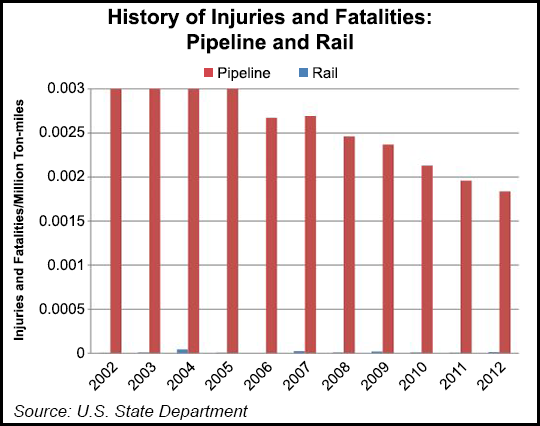NGI Archives | NGI All News Access
State Department: More Deadly Rail Wrecks if Keystone XL Not Built
The U.S. State Department has corrected several errors to its initial study examining the impact of the proposed Keystone XL pipeline, including a more than fourfold increase in the estimated number of deaths and injuries from rail accidents over a 10-year period without the pipeline.

In an errata sheet released Friday, the State Department said the Final Supplemental Environmental Impact Statement (FEIS) it issued in January had underestimated the number of injuries and fatalities that could occur with oil shipments via rail (see Shale Daily, Jan. 31).
“Subsequent to completion of the rail incident analysis, the department identified that the data obtained for the analysis from the Federal Railroad Administration [FRA] online safety data and statistics query system were incomplete due to an error in the search parameters used,” the State Department said. “As a result, the rail analysis was based on 40.6% of the 2002-2012 available incident data recorded on the FRA database. Therefore [several figures in the original FEIS] underreport the injury and fatality incident frequency…”
According to the State Department, the number of reported injuries increased from 700 to 2,947, and the fatalities increased from 92 to 434, after using a full annual incident dataset from FRA covering the 10-year period of 2002-2012. Using the updated statistics, the department increased its estimates for injuries from 49 to 189, and fatalities from six to 28.
“The rail incident analysis is based on nationwide statistics for Class I freight rail data obtained from the FRA database,” the State Department said. “Class I railroads are those with annual carrier operating revenues of $250 million or more, before adjustment for inflation. Because the dataset does not distinguish petroleum or crude oil rail transportation from that of other cargo, the statistics include all Class I rail freight.”
The State Department also clarified that 260 acres of land — not 190, as stated in the original FEIS — would be needed for aboveground facilities for the project, after including permanent access roads. The department also confirmed approximately 15,296 acres of land would be disturbed during the construction of Keystone XL, but clarified that the number would rise to 15,416 acres when rail sidings were included.
The U.S. Department of Transportation (DOT) has been investigating a series of train derailments involving rail cars containing crude oil from the Bakken Shale, and issued emergency orders on Bakken crude in February and May. Meanwhile, two DOT agencies –FRA and the Pipeline and Hazardous Materials Safety Administration — issued a safety advisory on rail cars in May (see Shale Daily, May 15; May 7; Feb. 26).
Last July, an unattended freight train transporting Bakken crude rolled downhill, derailed and exploded in Lac-Megantic, Quebec, killing 42 people (see Shale Daily, July 9, 2013).
Six months later, a 90-car crude oil train loaded with Bakken crude heading to a refinery in Florida derailed in a rural area near Aliceville, AL. According to DOT, more than 20 cars derailed and at least 11 ignited, causing an explosion and fire. Although no one was injured in the incident, an undetermined amount of crude fouled a wetlands area, causing an estimated $3.9 million in damage.
On Dec. 30, 2013, a BNSF train carrying Bakken crude hit a grain train traveling in the opposite direction that had derailed earlier near Casselton, ND. The crash caused 21 cars carrying crude to derail, 18 of which subsequently ruptured and exploded (see Shale Daily, Dec. 31, 2013). There were no injuries, but about 1,400 people were evacuated. Damage was estimated at $8 million.
The 1,700-mile Keystone XL pipeline requires State Department approval because it would cross an international border. TransCanada Corp. submitted a presidential permit application for the $7 billion project — designed to carry heavy crude from the Canadian oilsands from Morgan, MT, to Steele City, NE — in 2012 (see Shale Daily, May 7, 2012).
© 2024 Natural Gas Intelligence. All rights reserved.
ISSN © 2577-9877 | ISSN © 2158-8023 |
